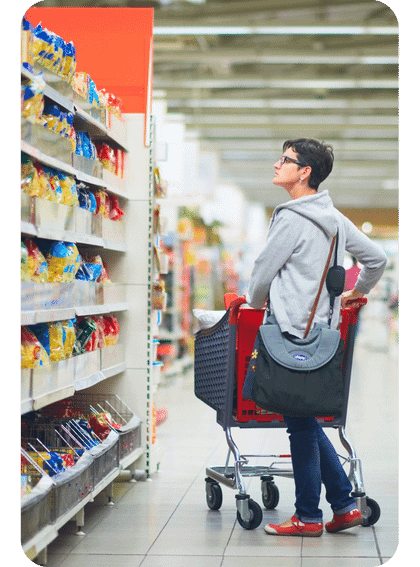 The growing supermarket industry—estimated to be worth $277.9 billion—relies on food packaging to transport and sell products. The demand for packaged food is also rising because consumers want quick and easy nutritional options. To make pre-packaged meals and convenient food products, manufacturers turn to single-serving packaging, resealable containers, and other innovations that make it possible to eat on the go.
The growing supermarket industry—estimated to be worth $277.9 billion—relies on food packaging to transport and sell products. The demand for packaged food is also rising because consumers want quick and easy nutritional options. To make pre-packaged meals and convenient food products, manufacturers turn to single-serving packaging, resealable containers, and other innovations that make it possible to eat on the go.
But there’s more to food packaging than convenience. Manufacturers also need to consider:
- Food freshness and storability
- Ease of transportation
- Food and Drug Administration (FDA) safety regulations
- Eco-friendly and sustainable packaging methods and recyclable materials
- Product security to avoid theft or tampering
- Packaging design, which affects the product’s marketability and sales
- Packaging cost
At Econo-Pak, food packaging meets all these needs and more. Our expert team has experience in package engineering and design and can even fulfill custom requests. The following guide explains what you need to know about ordering food packaging for your business.
Packaging Needs of the Supermarket Industry
 Branding and attractiveness: The aisles are lined with thousands of unique products at the supermarket. To stand out, your packaging needs to be aesthetically pleasing and eye-catching, and it must reinforce your brand image with key selling points. Many consumers make split-second purchasing decisions based on a product’s outward appearance, which means packaging has a sizeable impact on the manufacturer’s bottom line.
Branding and attractiveness: The aisles are lined with thousands of unique products at the supermarket. To stand out, your packaging needs to be aesthetically pleasing and eye-catching, and it must reinforce your brand image with key selling points. Many consumers make split-second purchasing decisions based on a product’s outward appearance, which means packaging has a sizeable impact on the manufacturer’s bottom line.
 Freshness/shelf-life preservation: Between 35%–50% of fresh fruits and vegetables are wasted in the U.S., and a significant portion of that loss happens in the retailer-to-consumer stage. Innovative packaging and sealing technology lower the respiration rate by controlling gas exchange inside and outside of the package. Pantry items and other non-produce foods require special sealing methods to preserve the taste and keep out contaminants.
Freshness/shelf-life preservation: Between 35%–50% of fresh fruits and vegetables are wasted in the U.S., and a significant portion of that loss happens in the retailer-to-consumer stage. Innovative packaging and sealing technology lower the respiration rate by controlling gas exchange inside and outside of the package. Pantry items and other non-produce foods require special sealing methods to preserve the taste and keep out contaminants.
 Ability to handle different states of matter: Supermarkets carry a variety of products, many of which require secure packaging to keep items contained and intact. A quality packaging company can provide solutions for liquid and solid foods to avoid spills and leakage.
Ability to handle different states of matter: Supermarkets carry a variety of products, many of which require secure packaging to keep items contained and intact. A quality packaging company can provide solutions for liquid and solid foods to avoid spills and leakage.
 Easy storage and distribution: Product packaging needs to be compact and stackable for easy transportation and storage. The right packaging design will protect against crushed corners, unstable columns, tears, and other potential mishaps.
Easy storage and distribution: Product packaging needs to be compact and stackable for easy transportation and storage. The right packaging design will protect against crushed corners, unstable columns, tears, and other potential mishaps.
 Environmentally friendly: Companies like Coca-Cola and Heinz have pushed initiatives to use completely recyclable, reusable, and compostable packaging materials. This aligns with rising consumer interest: Between 2013–2018, products marked as sustainable grew about 5.6 times faster than products without a sustainability claim.
Environmentally friendly: Companies like Coca-Cola and Heinz have pushed initiatives to use completely recyclable, reusable, and compostable packaging materials. This aligns with rising consumer interest: Between 2013–2018, products marked as sustainable grew about 5.6 times faster than products without a sustainability claim.
 Safety compliance: It’s critical to follow FDA regulations to help keep consumers safe and avoid potential legal ramifications and fines. Make sure your products are labeled appropriately according to the ingredients, nutritional content, and expiration date, and select packaging materials that seal out contaminants and avoid spoilage.
Safety compliance: It’s critical to follow FDA regulations to help keep consumers safe and avoid potential legal ramifications and fines. Make sure your products are labeled appropriately according to the ingredients, nutritional content, and expiration date, and select packaging materials that seal out contaminants and avoid spoilage.
Design Considerations for the Packaging Industry
- Materials: These mainly include paper, plastic, aluminum foil, and biodegradable packaging materials.
- Flexible vs. rigid build: Rigid builds are common for packaging large items and items delivered in bulk. Flexible and individual packaging is usually used for smaller items, as wells as on-the-go meals or snacks.
- Shape: When designing a containment option, the shape of the package depends on the material that’s being packaged. For example, triangle boxes are commonly used for individual pizza slices.
Grocery Packaging Methods
- Produce: Perishable items like produce require packages that maximize freshness and avoid spoilage.
- Meat: To seal in freshness and protect uncooked meat from bacteria, the package must be securely contained without leakage.
- Dairy products: Dairy products need to be properly sealed to prevent wasteful and potentially dangerous early expiration.
- Beverages: Beverages need to be packaged to avoid spills and retain freshness. If the beverage is carbonated, there must be enough carbon dioxide and pressure to create a gentle effervescence.
- Dry goods: Dry goods need to be protected against moisture to retain their consistency and avoid mold spores. As on-the-go eating options increase, many dry goods, like trail mix, for example, are packaged as single-portions.
- Snacks: Snack packaging is usually bright to catch a customer’s attention. There is a huge variety of snacking options, so a unique design and portability can help drive sales.
- Supplements: Many supermarkets carry supplements, which require secure packaging, as well as accurately printed instructions on their containers.
- Pre-portioned meals: Convenience is a top priority for packaging pre-portioned meals. For example, consumers prefer packaging that’s microwave-safe and includes clear directions for how to prepare the meal.
Each of the products listed above require some form of packaging, and the most commonly used packaging methods are:
- Pouch filling and sealing: Due to its durable and attractive design, pouch filling and sealing is a popular choice for a variety of supermarket products. The ability to attach a zip-seal to the pouch makes this process suitable for grocery items and helps retain freshness. It’s commonly used for high-end and economical items alike, including candy, coffee, and assorted pantry mixes.
- Vertical form fill sealing: A vertically oriented machine forms, fills, and seals the package quickly and efficiently. This versatile process is customizable and allows the manufacturer to use zip-seal or tear-away notches at the end of the package.
- Flow wrapping: Individually wrapped products such as chocolates are safely sealed with a polymer-based material. This quick and economical packaging method can be oriented horizontally or vertically.
After a product has been packaged, it’s then finished with labels, logos, and custom graphic printing. This final stage ensures your product is clearly labeled and stands out.
Contact the Food Packaging Experts at Econo-Pak
At Econo-Pak, we are proud to offer the following packaging services to our customers:
- Quality: Econo-Pak’s quality team of 45 personnel will ensure that your product will be distributed to customers in mint condition.
- Engineering department: Our superior technology and equipment processes are designed to maximize precise output and protect your product during shipping and handling.
- Variety of products and designs: We can provide effective containers for almost any product, in an unlimited number of packaging design types.
At Econo-Pak, we make product packaging and packaging design an easy process for manufacturers and food producers. With over 40 years of experience, we have the knowledge and expertise you need to deliver exceptional food in a reliable, safe, secure, and cost-effective package. We have provided packaging solutions for many supermarket products, including food, powders, baby products, and more. Request a quote to learn more about food packaging with Econo-Pak today.







